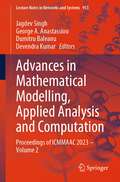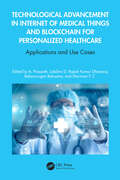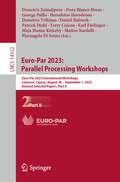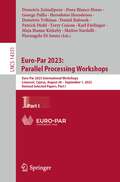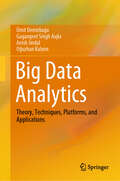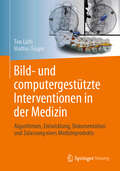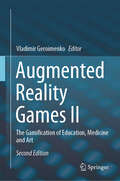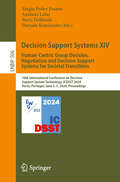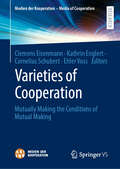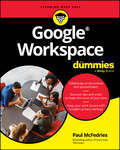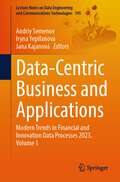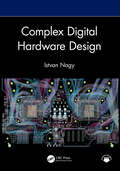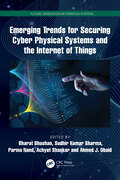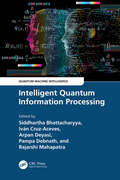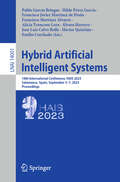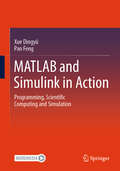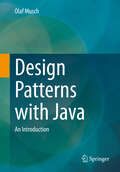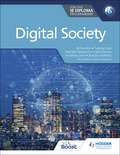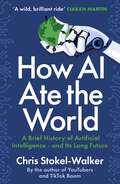- Table View
- List View
Qt 6 C++ GUI Programming Cookbook: Practical recipes for building cross-platform GUI applications, widgets, and animations with Qt 6
by Lee Zhi EngUse Qt 6 to design and build functional, appealing, and user-friendly graphical user interfaces (GUIs) for your applicationsKey FeaturesLearn to use Qt 6 to design and customize the look and feel of your applicationsImprove the visual quality of an application by using graphics rendering and animationUnderstand the balance of presentation and web content that will make an application appealing yet functionalPurchase of the print or Kindle book includes a free PDF eBookBook DescriptionWith the growing need to develop GUIs for multiple targets and multiple screens, improving the visual quality of your application has become pivotal in helping it stand out from your competitors. With its cross-platform ability and the latest UI paradigms, Qt makes it possible to build intuitive, interactive, and user-friendly UIs for your applications. The third edition of Qt 6 C++ GUI Programming Cookbook teaches you how to develop functional and appealing UIs using the latest version of Qt 6 and C++. This book will help you learn a variety of topics such as GUI customization and animation, graphics rendering, and implementing Google Maps. You’ll also be taken through advanced concepts such as asynchronous programming, event handling using signals and slots, network programming, and other aspects to optimize your application. By the end of this Qt book, you’ll have the confidence you need to design and customize GUI applications that meet your clients' expectations and have an understanding of best-practice solutions to common problems during the app development process.What you will learnAnimate GUI elements using Qt 6's built-in animation systemDraw vector shapes and bitmap images using Qt 6's powerful rendering systemImplement an industry-standard OpenGL library in your projectBuild a mobile app that supports touch events and export it into devicesParse and extract data from an XML file and present it on your GUIInteract with web content by calling JavaScript functions from C++Access MySQL and SQLite databases to retrieve data and display it on your GUIWho this book is forThis intermediate-level book is designed for those who want to develop software using Qt 6. If you want to improve the visual quality and content presentation of your software application, this book is for you. Prior experience with the C++ programming language is required.
Enterprise GENERATIVE AI Well-Architected Framework & Patterns: An Architect's Real-life Guide to Adopting Generative AI in Enterprises at Scale
by Suvoraj BiswasElevate your AI projects with our course on Enterprise Generative AI using AWS's Well-Architected Framework, paving the way for innovation and efficiencyKey FeaturesLearn to secure AI environmentsAchieve excellence in AI architectureImplement AI with AWS solutionsBook DescriptionThe course begins with an insightful introduction to the burgeoning field of Generative AI, laying down a robust framework for understanding its applications within the AWS ecosystem. The course focuses on meticulously detailing the five pillars of the AWS Well-Architected Framework—Operational Excellence, Security, Compliance, Reliability, and Cost Optimization. Each module is crafted to provide you with a comprehensive understanding of these essential areas, integrating Generative AI technologies. You'll learn how to navigate the complexities of securing AI systems, ensuring they comply with legal and regulatory standards, and designing them for unparalleled reliability. Practical sessions on cost optimization strategies for AI projects will empower you to deliver value without compromising on performance or scalability. Furthermore, the course delves into System Architecture Excellence, emphasizing the importance of robust design principles in creating effective Generative AI solutions. The course wraps up by offering a forward-looking perspective on the Common Architectural Pattern for FM/LLM Integration & Adoption within the AWS framework. You'll gain hands-on experience with AWS solutions specifically tailored for Generative AI applications, including Lambda, API Gateway, and DynamoDB, among others.What you will learnApply Operational Excellence in AISecure Generative AI implementationsNavigate compliance in AI solutionsEnsure reliability in AI systemsOptimize costs for AI projectsIntegrate FM/LLM with AWS solutionsWho this book is forThis course is designed for IT professionals, solutions architects, and DevOps engineers looking to specialize in Generative AI. A foundational understanding of AWS and cloud computing is beneficial.
Advances in Mathematical Modelling, Applied Analysis and Computation: Proceedings of ICMMAAC 2023 – Volume 2 (Lecture Notes in Networks and Systems #953)
by Jagdev Singh George A. Anastassiou Dumitru Baleanu Devendra KumarThis book gathers selected research articles presented in the “6th International Conference on Mathematical Modelling, Applied Analysis and Computation (ICMMAAC)”, held at JECRC University, Jaipur, during August 3–5, 2023. This book is focused on articles dealing with necessary theory and techniques in a balanced manner, and contributes towards solving mathematical problems arising in physics, engineering, chemistry, biological systems, medicine, networking system, control systems, environmental sciences, social issues of current interest and more. Annually held since 2018, the ICMMAAC conference aimed, in particular, to foster cooperation among practitioners and theoreticians in these fields. This proceedings is an invaluable resource for researchers, academicians and professionals associated or interested in current advances in different aspects of mathematical modelling, computational algorithms and analysis necessary for handling real-world problems.
Technological Advancement in Internet of Medical Things and Blockchain for Personalized Healthcare: Applications and Use Cases
by A. Prasanth D Lakshmi Rajesh Kumar Dhanaraj Balamurugan BalusamyTechnological Advancement in Internet of Medical Things and Blockchain for Personalized Healthcare presents an overview of the innovative concepts, technologies, and various biomedical applications of the Internet of Medical Things (IoMT).Features:• Provides insights into smart contracts, healthcare monitoring equipment, and the next generation of Internet of Things sensors to improve adherence to chronic disease management programs and patient health.• Discusses the IoMT for personalized healthcare, security, and privacy issues of the IoMT in the healthcare sector.• Elaborates on the opportunities and challenges of blockchain technology in the healthcare system.• Focuses on the convergence of the IoMT and blockchain for emerging personalized healthcare systems.• Presents techniques and methods to secure IoMT devices to protect them from cyberattacks.This book is primarily written for graduate students and academic researchers working in the fields of computer science and engineering, biomedical engineering, and electrical engineering.
Technological Advancement in Internet of Medical Things and Blockchain for Personalized Healthcare: Applications and Use Cases
Technological Advancement in Internet of Medical Things and Blockchain for Personalized Healthcare presents an overview of the innovative concepts, technologies, and various biomedical applications of the Internet of Medical Things (IoMT).Features:• Provides insights into smart contracts, healthcare monitoring equipment, and the next generation of Internet of Things sensors to improve adherence to chronic disease management programs and patient health.• Discusses the IoMT for personalized healthcare, security, and privacy issues of the IoMT in the healthcare sector.• Elaborates on the opportunities and challenges of blockchain technology in the healthcare system.• Focuses on the convergence of the IoMT and blockchain for emerging personalized healthcare systems.• Presents techniques and methods to secure IoMT devices to protect them from cyberattacks.This book is primarily written for graduate students and academic researchers working in the fields of computer science and engineering, biomedical engineering, and electrical engineering.
Euro-Par 2023: Euro-Par 2023 International Workshops, Limassol, Cyprus, August 28 – September 1, 2023, Revised Selected Papers, Part II (Lecture Notes in Computer Science #14352)
by Demetris Zeinalipour Dora Blanco Heras George Pallis Herodotos Herodotou Demetris Trihinas Daniel Balouek Patrick Diehl Terry Cojean Karl Fürlinger Maja Hanne Kirkeby Matteo Nardelli Pierangelo Di SanzoThis book constitutes revised selected papers from the workshops held at the 29th International Conference on Parallel and Distributed Computing, Euro-Par 2023, which took place in Limassol, Cyprus, during August 28–September 1, 2023. The 42 full papers presented in this book together with 11 symposium papers and 14 demo/poster papers were carefully reviewed and selected from 55 submissions. The papers cover covering all aspects of parallel and distributed processing, ranging from theory to practice, from small to the largest parallel and distributed systems and infrastructures, from fundamental computational problems to applications, from architecture, compiler, language and interface design and implementation, to tools, support infrastructures, and application performance aspects. LNCS 14351: First International Workshop on Scalable Compute Continuum (WSCC 2023). First International Workshop on Tools for Data Locality, Power and Performance (TDLPP 2023). First International Workshop on Urgent Analytics for Distributed Computing (QuickPar 2023). 21st International Workshop on Algorithms, Models and Tools for Parallel Computing on Heterogeneous Platforms (HETEROPAR 2023). LNCS 14352: Second International Workshop on Resource AWareness of Systems and Society (RAW 2023). Third International Workshop on Asynchronous Many-Task systems for Exascale (AMTE 2023). Third International Workshop on Performance and Energy-efficiency in Concurrent and Distributed Systems (PECS 2023) First Minisymposium on Applications and Benefits of UPMEM commercial Massively Parallel Processing-In-Memory Platform (ABUMPIMP 2023). First Minsymposium on Adaptive High Performance Input / Output Systems (ADAPIO 2023).
Euro-Par 2023: Euro-Par 2023 International Workshops, Limassol, Cyprus, August 28 – September 1, 2023, Revised Selected Papers, Part I (Lecture Notes in Computer Science #14351)
by Demetris Zeinalipour Dora Blanco Heras George Pallis Herodotos Herodotou Demetris Trihinas Daniel Balouek Patrick Diehl Terry Cojean Karl Fürlinger Maja Hanne Kirkeby Matteo Nardelli Pierangelo Di SanzoThis book constitutes revised selected papers from the workshops held at the 29th International Conference on Parallel and Distributed Computing, Euro-Par 2023, which took place in Limassol, Cyprus, during August 28–September 1, 2023. The 42 full papers presented in this book together with 11 symposium papers and 14 demo/poster papers were carefully reviewed and selected from 55 submissions. The papers cover covering all aspects of parallel and distributed processing, ranging from theory to practice, from small to the largest parallel and distributed systems and infrastructures, from fundamental computational problems to applications, from architecture, compiler, language and interface design and implementation, to tools, support infrastructures, and application performance aspects.LNCS 14351:First International Workshop on Scalable Compute Continuum (WSCC 2023). First International Workshop on Tools for Data Locality, Power and Performance (TDLPP 2023). First International Workshop on Urgent Analytics for Distributed Computing (QuickPar 2023). 21st International Workshop on Algorithms, Models and Tools for Parallel Computing on Heterogeneous Platforms (HETEROPAR 2023). LNCS 14352: Second International Workshop on Resource AWareness of Systems and Society (RAW 2023). Third International Workshop on Asynchronous Many-Task systems for Exascale (AMTE 2023). Third International Workshop on Performance and Energy-efficiency in Concurrent and Distributed Systems (PECS 2023) First Minisymposium on Applications and Benefits of UPMEM commercial Massively Parallel Processing-In-Memory Platform (ABUMPIMP 2023). First Minsymposium on Adaptive High Performance Input / Output Systems (ADAPIO 2023).
Big Data Analytics: Theory, Techniques, Platforms, and Applications
by Ümit Demirbaga Gagangeet Singh Aujla Anish Jindal Oğuzhan KalyonThis book introduces readers to big data analytics. It covers the background to and the concepts of big data, big data analytics, and cloud computing, along with the process of setting up, configuring, and getting familiar with the big data analytics working environments in the first two chapters. The third chapter provides comprehensive information on big data processing systems - from installing these systems to implementing real-world data applications, along with the necessary codes. The next chapter dives into the details of big data storage technologies, including their types, essentiality, durability, and availability, and reveals their differences in their properties. The fifth and sixth chapters guide the reader through understanding, configuring, and performing the monitoring and debugging of big data systems and present the available commercial and open-source tools for this purpose. Chapter seven gives information about a trending machine learning, Bayesian network: a probabilistic graphical model, by presenting a real-world probabilistic application to understand causal, complex, and hidden relationships for diagnosis and forecasting in a scalable manner for big data. Special sections throughout the eighth chapter present different case studies and applications to help the readers to develop their big data analytics skills using various big data analytics frameworks.The book will be of interest to business executives and IT managers as well as university students and their course leaders, in fact all those who want to get involved in the big data world.
Bild- und computergestützte Interventionen in der Medizin: Algorithmen, Entwicklung, Dokumentation und Zulassung eines Medizinprodukts
by Tim Christian Lüth Mattias Felix TrägerDieses Buch richtet sich an Ingenieure, Informatiker sowie interessierte Angehörige der medizinischen und pflegerischen Berufe. Es erklärt die Grundlagen und Anwendungen der computerassistierten- und robotergestützten Medizingeräte auf dem aktuellen Stand der Technik. Derartige Systeme haben in den letzten 20 Jahren revolutionäre positive Veränderungen in der Radiologie, bei Interventionen und in vielen Gebieten der Chirurgie bewirkt. Mit dieser Technik ist es möglich, Bilddaten aus unterschiedlichen bildgebenden Systemen – wie z.B. Computertomograph, Ultraschall-gerät oder Videoendoskop – zu fusionieren, am Bildschirm dreidimensional darzustellen und darin mit dem Computer Eingriffe zu planen. Während der Operation wird die räumliche Lage des navigierten Instruments gemessen und im 3D-Modell des Patienten am Bildschirm dargestellt. Geplante Pfade der Instrumente werden eingeblendet, es wird vor Risiken bei Abweichungen von der Planung gewarnt und es können aktive Instrumente wie Bohrer, Fräser, Laser oder sogar Roboter automatisiert gesteuert werden. Die Autoren sind auf diesem Gebiet seit über 25 Jahren sowohl wissenschaftlich als auch unternehmerisch international führend tätig, weshalb in diesem Buch auch Entwicklungsmethodik, Dokumentation, Zulassung und Inverkehrbringung als Medizinprodukt praxisnah erläutert werden.
Augmented Reality Games II: The Gamification of Education, Medicine and Art
by Vladimir GeroimenkoThis is the second edition of the first ever research monograph that explores the exciting field of augmented reality games and their enabling technologies. The new edition has been thoroughly revised and updated, with 6 new chapters included. As well as investigating augmented reality games in education, the book covers the gamification of medicine, healthcare, and art. It has been written by a team of 43 researchers, practitioners, and artists from 12 countries, pioneering in developing and researching the new type of computer games.This book deals with a systematic analysis of educational augmented reality games, the gamification of elementary and secondary education, teachers’ novel key skills and new teaching methods in the classroom, creating immersive and playful reading experiences, augmented reality games for health promotion in old age and for transforming dental and physical education and practice, the gamification of augmented reality art, pervasive games, and gaming in public spaces, among other topics.Intended as a starting point for exploring this new fascinating area of research and game development, it will be essential reading not only for researchers, practitioners, game developers, and artists, but also for students (graduates and undergraduates) and all those interested in the rapidly developing area of augmented reality games.
Decision Support Systems XIV. Human-Centric Group Decision, Negotiation and Decision Support Systems for Societal Transitions: 10th International Conference on Decision Support System Technology, ICDSST 2024, Porto, Portugal, June 3–5, 2024, Proceedings (Lecture Notes in Business Information Processing #506)
by Sérgio Pedro Duarte António Lobo Boris Delibašić Daouda KamissokoThis book constitutes the proceedings of the 10th International Conference on Decision Support Systems Technologies, ICDSST 2024, held in June 2024. The EWG-DSS series of International Conference on Decision Support System Technology (ICDSST) is planned to consolidate the tradition of annual events organized by the EWG-DSS in offering a platform for European and international DSS communities, comprising the academic and industrial sectors, to present state-of-the-art DSS research and developments, to discuss current challenges that surround decision-making processes, to exchange ideas about realistic and innovative solutions, and to co-develop potential business opportunities. This year the main topic was: Human-Centric Group Decision, Negotiation and Decision Support Systems for Societal Transitions. The 10 full papers included in these proceedings were carefully reviewed and selected from 29 submissions. They have been organized in topical sections as follows: Decision support tools and methods; and decision factors.
Varieties of Cooperation: Mutually Making the Conditions of Mutual Making (Medien der Kooperation – Media of Cooperation)
by Clemens Eisenmann Kathrin Englert Cornelius Schubert Ehler VossThis volume conceives cooperation in broad terms as any form of mutual making, in which goals, means, and procedures are seen as ongoing accomplishments. From the exchanges of goods or information, to the interactions between bodies or organizations, and the coordination between colleagues, competitors, friends or foes. Mutually making the conditions of mutual making entails translating heterogeneous interests, negotiating conflicting values and articulating distributed activities. On the one hand, the contributions cover different notions and concepts of cooperation in diverse fields of study: from the mundane cooperation of everyday life to collective endeavors within specific domains. On the other hand, the contributions share a focus on the practices of making cooperation possible through cooperatively creating the conditions for cooperation itself. Seeing cooperative media both as a condition and consequence of cooperation, the volume sheds light on a general feature of media, technologies and instruments that both enable and constrain the collaboration between heterogeneous social worlds, with and without consensus. Chapter 7 “The Passport as a Medium of Movement” is available open access under a Creative Commons Attribution 4.0 International License via SpringerLink.
Google Workspace For Dummies
by Paul McFedriesEasy advice for getting the most out of Google Workspace for school, work, or personal use Google Workspace For Dummies is here to show you the tips and tricks for upping your productivity with Google's cloud-based software suite. This book includes jargon-free instructions on using Gmail, Calendar, Docs, Sheets, Drive, Chat, and Meet. You'll learn about the AI features, updated security, compatibility with other apps, picture-in-picture capability for video meetings, and beyond. Plus, you'll get info on Google's Forms and Notes feature that makes it simple to gather and share data and stay up-to-date with your team. It's easier than ever to collaborate securely in the cloud, thanks to this Dummies book. Learn how to collaborate with colleagues in real time using the programs that come with Google Workspace Create and edit contacts, and set up video meetings Work on slides, spreadsheets, and documents Discover tips and tricks to increase productivity and keep your work secure Google Workspace For Dummies is a must for business users and workers who use Google applications on the job. Casual users and students, you'll love it, too.
Data-Centric Business and Applications: Modern Trends in Financial and Innovation Data Processes 2023. Volume 1 (Lecture Notes on Data Engineering and Communications Technologies #195)
by Andriy Semenov Iryna Yepifanova Jana KajanováThis book examines aspects of financial and investment processes, as well as the application of information technology mechanisms to business and industrial management, using the experience of the Ukrainian economy as an example. An effective tool for supporting business data processing is combining modern information technologies and the latest achievements in economic theory. The variety of industrial sectors studied supports the continuous acquisition and use of efficient business analysis in organizations. In addition, the book elaborates on multidisciplinary concepts, examples, and practices that can be useful for researching the evolution of developments in the field. Also, in this book, there is a description of analysis methods for making decisions in business, finance, and innovation management.
Complex Digital Hardware Design
by Istvan NagyThis book is about how to design the most complex types of digital circuit boards used inside servers, routers and other equipment, from high-level system architecture down to the low-level signal integrity concepts. It explains common structures and subsystems that can be expanded into new designs in different markets.The book is targeted at all levels of hardware engineers. There are shorter, lower-level introductions to every topic, while the book also takes the reader all they way to the most complex and most advanced topics of digital circuit design, layout design, analysis, and hardware architecture.
Complex Digital Hardware Design
by Istvan NagyThis book is about how to design the most complex types of digital circuit boards used inside servers, routers and other equipment, from high-level system architecture down to the low-level signal integrity concepts. It explains common structures and subsystems that can be expanded into new designs in different markets.The book is targeted at all levels of hardware engineers. There are shorter, lower-level introductions to every topic, while the book also takes the reader all they way to the most complex and most advanced topics of digital circuit design, layout design, analysis, and hardware architecture.
Emerging Trends for Securing Cyber Physical Systems and the Internet of Things (Future Generation Information Systems)
In the past decades, cyber-physical systems (CPSs) have been widely applied to fields such as smart grids, environment monitoring, aerospace, smart transportation, and industrial automation. Great strides have been made in CPSs to improve the computing mechanism, communication, and quality of service by applying optimization algorithms. Currently, these efforts are integrated with the applications of machine learning (ML) and artificial intelligence (AI). To maintain system reliability and stability, CPSs such as smart grids face numerous challenges, including large-scale Internet-of-Things (IoT) device adaptation, ever-increasing demands of electrical energy, and the rise of a wide range of security threats. These challenges bring forth the need to find sustainable and advanced solutions to guarantee reliable and secure operations in these systems.The goal of this book is to foster transformative, multidisciplinary, and novel approaches that ensure CPS security by taking into consideration the unique security challenges present in the environment. This book attracts contributions in all aspects pertaining to this multidisciplinary paradigm, which includes the development and implementation of Smart CPS, Supervisory Control and Data Acquisition (SCADA) systems, CPS for Industry 4.0, CPS architecture for IoT applications, and CPS forensics.This book: Discusses concepts including wireless sensor networks (WSNs), CPSs, and the IoT in a comprehensive manner. Covers routing protocols in sensor networks, attacks, and vulnerabilities in WSNs, the Internet of Cyber-Physical Things, and CPSs for industrial applications. Highlights technological advances, practical solutions, emerging trends, and prototypes related to privacy in CPSs and the IoT. Presents a pathway and architecture for proactive security schemes in CPSs to counter vulnerabilities, including phishing attacks, malware injection, internal stealing of data, and hacking. Discusses the most recent research and development on the enabling technologies for IoT-based CPSs. Owing to the scope and diversity of topics covered, the book will be of interest not only to researchers and theorists but also to professionals, material developers, technology specialists, and methodologists dealing with the multifarious aspects of data privacy and security enhancement in CPSs. The book will provide these professionals an overview of CPS security and privacy design, as well as enlighten them to promising solutions to research problems such as cyberattacks in CPS, risk identification and management in CPS, ML-based trust computational models for CPSs, nature-inspired algorithms for CPSs, and distributed consensus algorithms for event detection in CPSs. The secondary target audience of this book includes legal practitioners, hackers, cyber law policymakers, cyber forensic analysts, and global security consortiums who may use it to further their research exposure to pertinent topics in cybersecurity.
Intelligent Quantum Information Processing (Quantum Machine Intelligence)
The book discusses the foundations of intelligent quantum information processing applied to several real-life engineering problems, including intelligent quantum systems, intelligent quantum communication, intelligent process optimization, and intelligent quantum distributed networks.This book:• Showcases a detailed overview of different quantum machine learning algorithmic frameworks.• Presents real-life case studies and applications.• Provides an in-depth analysis of quantum mechanical principles.• Provides a step-by-step guide in the build-up of quantum inspired/quantum intelligent information processing systems.• Provides a video demonstration on each chapter for better understanding.It will serve as an ideal reference text for graduate students and academic researchers in fields such as electrical engineering, electronics and communication engineering, computer engineering, and information technology.
Intelligent Quantum Information Processing (Quantum Machine Intelligence)
by Siddhartha Bhattacharyya Iván Cruz-Aceves Arpan Deyasi Pampa Debnath Rajarshi MahapatraThe book discusses the foundations of intelligent quantum information processing applied to several real-life engineering problems, including intelligent quantum systems, intelligent quantum communication, intelligent process optimization, and intelligent quantum distributed networks.This book:• Showcases a detailed overview of different quantum machine learning algorithmic frameworks.• Presents real-life case studies and applications.• Provides an in-depth analysis of quantum mechanical principles.• Provides a step-by-step guide in the build-up of quantum inspired/quantum intelligent information processing systems.• Provides a video demonstration on each chapter for better understanding.It will serve as an ideal reference text for graduate students and academic researchers in fields such as electrical engineering, electronics and communication engineering, computer engineering, and information technology.
Emerging Trends for Securing Cyber Physical Systems and the Internet of Things (Future Generation Information Systems)
by Bharat Bhushan Sudhir Kumar Sharma Parma Nand Achyut Shankar Ahmed J. ObaidIn the past decades, cyber-physical systems (CPSs) have been widely applied to fields such as smart grids, environment monitoring, aerospace, smart transportation, and industrial automation. Great strides have been made in CPSs to improve the computing mechanism, communication, and quality of service by applying optimization algorithms. Currently, these efforts are integrated with the applications of machine learning (ML) and artificial intelligence (AI). To maintain system reliability and stability, CPSs such as smart grids face numerous challenges, including large-scale Internet-of-Things (IoT) device adaptation, ever-increasing demands of electrical energy, and the rise of a wide range of security threats. These challenges bring forth the need to find sustainable and advanced solutions to guarantee reliable and secure operations in these systems.The goal of this book is to foster transformative, multidisciplinary, and novel approaches that ensure CPS security by taking into consideration the unique security challenges present in the environment. This book attracts contributions in all aspects pertaining to this multidisciplinary paradigm, which includes the development and implementation of Smart CPS, Supervisory Control and Data Acquisition (SCADA) systems, CPS for Industry 4.0, CPS architecture for IoT applications, and CPS forensics.This book: Discusses concepts including wireless sensor networks (WSNs), CPSs, and the IoT in a comprehensive manner. Covers routing protocols in sensor networks, attacks, and vulnerabilities in WSNs, the Internet of Cyber-Physical Things, and CPSs for industrial applications. Highlights technological advances, practical solutions, emerging trends, and prototypes related to privacy in CPSs and the IoT. Presents a pathway and architecture for proactive security schemes in CPSs to counter vulnerabilities, including phishing attacks, malware injection, internal stealing of data, and hacking. Discusses the most recent research and development on the enabling technologies for IoT-based CPSs. Owing to the scope and diversity of topics covered, the book will be of interest not only to researchers and theorists but also to professionals, material developers, technology specialists, and methodologists dealing with the multifarious aspects of data privacy and security enhancement in CPSs. The book will provide these professionals an overview of CPS security and privacy design, as well as enlighten them to promising solutions to research problems such as cyberattacks in CPS, risk identification and management in CPS, ML-based trust computational models for CPSs, nature-inspired algorithms for CPSs, and distributed consensus algorithms for event detection in CPSs. The secondary target audience of this book includes legal practitioners, hackers, cyber law policymakers, cyber forensic analysts, and global security consortiums who may use it to further their research exposure to pertinent topics in cybersecurity.
Hybrid Artificial Intelligent Systems: 18th International Conference, HAIS 2023, Salamanca, Spain, September 5–7, 2023, Proceedings (Lecture Notes in Computer Science #14001)
by Pablo García Bringas Hilde Pérez García Francisco Javier Martínez de Pisón Francisco Martínez Álvarez Alicia Troncoso Lora Álvaro Herrero José Luis Calvo Rolle Héctor Quintián Emilio CorchadoThis book constitutes the refereed proceedings of the 18th International Conference on Hybrid Artificial Intelligent Systems, HAIS 2023, held in Salamanca, Spain, during September 5–7, 2023.The 65 full papers included in this book were carefully reviewed and selected from 120 submissions. They were organized in topical sections as follows: Anomaly and Fault Detection, Data Mining and Decision Support Systems, Deep Learning, Evolutionary Computation and Optimization, HAIS Applications, Image and Speech Signal Processing, Agents and Multiagents, Biomedical Applicatons.
MATLAB and Simulink in Action: Programming, Scientific Computing and Simulation
by Dingyü Xue Feng PanThe textbook is intended for teaching MATLAB language and its applications. The book is composed of three parts: MATLAB programming, scientific computing with MATLAB, and system simulation with Simulink. Since MATLAB is widely used in all fields of science and engineering, a good introduction to the language can not only help students learn how to use it to solve practical problems, but also provide them with the skills to use MATLAB independently in their later courses and research. The three parts of the book are well-balanced and tailored to the needs of engineering students, and the mathematical problems commonly encountered in engineering can be easily solved using MATLAB. This textbook is suitable for undergraduate and graduate students majoring in science and engineering.
Design Patterns with Java: An Introduction
by Olaf MuschA practical description of the software design patterns as they are mentioned in the 1994 book "Design Patterns - Elements of Reusable ObjectOriented Software" by the author group Gamma, Helm, Johnson and Vlissides (also called "Gang of Four", GoF for short). All patterns are explained in detail by means of examples and also critically appreciated. Furthermore, design principles of object-oriented programming are described and considered. All examples are commented in detail in the source code and are executable under Java 16. In part, newer features of Java up to and including version 16 are also explained and used.
Digital Society for the IB Diploma
by Eli Bomfim Tammy Earle Michael Fitzpatrick Carol Hancox Jonathon Levin Barbara StefanicsDeveloped in cooperation with the International Baccalaureate®Ensure full coverage of the new Digital Society course with this accessible coursebook written by an experienced international team of IB educators and examiners, enabling students to build skills and understand the importance and impact of digital systems and technologies in the contemporary world.- Explore digital society through the key concepts, content and contexts of the syllabus with clear, real world, internationally-minded examples for each topic.- Delve into the higher-level extension challenges and interventions in digital society using contemporary,real-world issues that allow students to formulate their own recommendations, with chapter reflections to consolidate learning throughout.- Essential tools for inquiry are integrated throughout the course, with links to ATL, TOK, and extended essay.- Specific chapters and activities are featured for conducting inquiries suitable for SL and HL students, with added extended inquiries for HL students.- Prepare for the inquiry project with step-by-step guidance, advice, practice questions and top tips onhow to maximise potential in the assessment.
How AI Ate the World: A Brief History of Artificial Intelligence - and Its Long Future
by Chris Stokel-Walker• Popular 'start here' guide to the next big tech wave • People want to know about AI because of its power (AI is a top web search topic) • An accessible, expert guide by the author of the first popular book on TikTok

